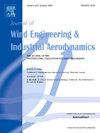高层建筑单极子在大气边界层风作用下的气动弹性试验
IF 4.9
2区 工程技术
Q1 ENGINEERING, CIVIL
Journal of Wind Engineering and Industrial Aerodynamics
Pub Date : 2025-06-11
DOI:10.1016/j.jweia.2025.106149
引用次数: 0
摘要
高层建筑的现代建筑设计已经发展到包括一个更高的尖顶,以进一步增加建筑物的高度,或通过利用屋顶安装的结构,如单极子或晶格塔,结合电信设备。然而,由于其高度和灵活性,屋顶安装结构对风激振动的敏感性成为一个问题,特别是当它与建筑相关的振动耦合时。先前的研究已经解决了高层建筑单独或地面安装的电信结构的风致响应,在理解其屋顶安装的复制品的行为方面留下了空白。为此,本文通过气动弹性风试验研究了车顶单极子的动力响应。建立了一个几何比例为1:150的2自由度气动弹性模型,以表示一座166米高的高层建筑,其屋顶上安装了一个40米高的空心单极子。本文考虑了不同的风速和支撑建筑的结构阻尼条件。结果表明,对于不同的Scruton数,建筑物的风致振动显著放大了屋顶单极子的响应。此外,建筑物的振动特性可能反映在单极子的响应中,从而引起响应的放大。建筑物的横风响应极大地影响了屋顶单极子的动态响应,而目前的标准忽略了这一影响。结果表明,基于作用于单极子尖端的横风向风力的均方根(RMS),放大系数最大可达8.83。此外,与建筑物相关的旋涡脱落效应导致单极子过度振动,特别是在低斯克鲁顿数时。本研究为弥合文献中的现有差距奠定了基础,并为屋顶单极子的风致动力学提供了基础见解,这可能为未来建筑规范和标准的进步提供信息。本文章由计算机程序翻译,如有差异,请以英文原文为准。
Aeroelastic testing of monopole mounted on a high-rise building under atmospheric boundary layer wind
Modern architectural designs of high-rise buildings have evolved to comprise a higher pinnacle to further increase the building height or to incorporate telecommunication devices by utilizing roof-mounted structures such as monopoles or lattice towers. However, due to their height and flexibility, the susceptibility of roof-mounted structures to wind-induced vibrations becomes a concern, especially when it couples with building-associated vibrations. Prior studies have addressed the wind-induced response of either high-rise buildings solely or ground-mounted telecommunication structures, leaving a gap in understanding the behavior of their roof-mounted replicas. To that end, this paper investigates the dynamic response of roof-mounted monopoles through an aeroelastic wind testing campaign. A 2-DOF aeroelastic model with a geometric scaling of 1:150 was developed to represent a 166-m high-rise building with a 40-m tall hollow-sectioned monopole mounted on the rooftop. This paper considers varying wind speeds and structural damping conditions of the supporting building. Results indicate that wind-induced vibrations of the building significantly amplify the response of the roof-mounted monopole for different Scruton numbers. Additionally, the vibrational characteristics of the building may be reflected in the monopole's response, inducing an amplification in the response. The across-wind response of the building greatly influences the dynamic response of roof-mounted monopoles, an effect that current standards overlook. The findings suggest maximum magnification factors of 8.83 based on the root-mean-square (RMS) of wind forces acting on the tip of the monopole in the across-wind direction. Furthermore, vortex-shedding effects associated with the building cause excessive vibration in the monopole, particularly at low Scruton numbers. This study lays the foundation for bridging the existing gap in the literature and provides foundational insights into wind-induced dynamics of roof-mounted monopoles that potentially inform future advancements in building codes and standards.
求助全文
通过发布文献求助,成功后即可免费获取论文全文。
去求助
来源期刊
CiteScore
8.90
自引率
22.90%
发文量
306
审稿时长
4.4 months
期刊介绍:
The objective of the journal is to provide a means for the publication and interchange of information, on an international basis, on all those aspects of wind engineering that are included in the activities of the International Association for Wind Engineering http://www.iawe.org/. These are: social and economic impact of wind effects; wind characteristics and structure, local wind environments, wind loads and structural response, diffusion, pollutant dispersion and matter transport, wind effects on building heat loss and ventilation, wind effects on transport systems, aerodynamic aspects of wind energy generation, and codification of wind effects.
Papers on these subjects describing full-scale measurements, wind-tunnel simulation studies, computational or theoretical methods are published, as well as papers dealing with the development of techniques and apparatus for wind engineering experiments.

 求助内容:
求助内容: 应助结果提醒方式:
应助结果提醒方式:


